Description
The coat of arms of Galicia includes, enclosed in a field of azure, a chalice of gold with a silver host, accompanied by seven silver crosses, three on each side and one in the center of the shield (representative of the seven historic provinces of Galicia).
The royal crown in gules, i.e. red, enclosed in a golden ring set with precious stones, made up of eight acanthus leaf fleurons, out of which five are visible. Each leaf is set with pearls, and five tiaras are born from them to converge in a globe of azure, with the semi-meridian and the equator in gold, topped by a golden cross.
History
The historians Faustino Menéndez-Pidal and Juan José Sánchez Badiola find the first references to it in two rolls of arms from the late 13th century – in Segar's Roll and in the Armorial du Hérault Vermandois – which attribute the coat of arms to the king of Galicia, although by that time it no longer existed as a separate title. The first source describes three uncovered chalices, whereas the second only describes one covered chalice.
Since the Middle Ages, the concept of the chalice as a canting linguistic metaphor spread: chalice = Galice; many European authors eventually theorized about this fact from the 16th to the 18th centuries, a fact the Romanticist Galician author Manuel Murguía would later echo. Later rolls of arms also make reference to it, e.g. the Armorial Gymnich of Flanders (1445), and, especially, the Armorial Bergshammar, a compilation of some 3300 coats of arms belonging to states and families of almost all over Europe as of 1436. In that roll of arms it says "in the fourth turned sheet... a well-stylized big cup occupying as much space of the field as possible". Above the composition the word Galiscién (Galicia) is written.
The most ancient remaining representations of the coat of arms in Galician civil architecture are also from the 15th century depicted in the Royal hospital of Santiago de Compostela, Betanzos town hall, Corunna walls, Lugo Cathedral's organ, Noia Church's tower, Moscosos residence in Laxe.
From the 16th century onwards, crosses were added around the chalice as ornamentation.
Joseph de Avilés, in "Heroic science", defined the coat of arms: "The kingdom of Galicia in Spain includes a field of azure with scattered crosses and a big golden cup and chalice".
Coat of arms of the kings of Galicia (Segar's Roll). 13th century.
Coat of arms of the Kingdom of Galicia (L'armorial Le Blancq, c. 1560 AD).
Flag and arms of the Kingdom of Galicia (16th century). The picture shows the funerals of the emperor
Charles V, also king of Galicia (
Funerals of Charles V, by Lucas Doetecum).
Coat of arms of the Kingdom of Galicia (c. 1625 AD).
Coat of arms of the Kingdom of Galicia.
Betanzos, 16th century.
Coat of arms of the Kingdom of Galicia. Betanzos.
Coat of arms of the Kingdom of Galicia. Betanzos.

Galicia is an autonomous community of Spain and historic nationality under Spanish law. Located in the northwest Iberian Peninsula, it includes the provinces of A Coruña, Lugo, Ourense, and Pontevedra.

Santiago de Compostela or Compostela is the capital of the autonomous community of Galicia, in northwestern Spain. The city has its origin in the shrine of Saint James the Great, now the Cathedral of Santiago de Compostela, as the destination of the Way of St. James, a leading Catholic pilgrimage route since the 9th century. In 1985, the city's Old Town was designated a UNESCO World Heritage Site.
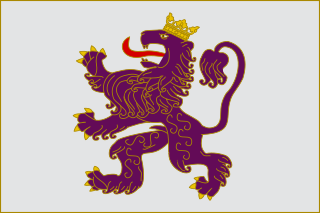
The Kingdom of León was an independent kingdom situated in the northwest region of the Iberian Peninsula. It was founded in 910 when the Christian princes of Asturias along the northern coast of the peninsula shifted their capital from Oviedo to the city of León. The kings of León fought civil wars, wars against neighbouring kingdoms, and campaigns to repel invasions by both the Moors and the Vikings, all in order to protect their kingdom's changing fortunes.

The coat of arms of Ireland is blazoned as Azure a harp Or, stringed Argent. These arms have long been Ireland's heraldic emblem. References to them as being the arms of the king of Ireland can be found as early as the 13th century. These arms were adopted by Henry VIII of England when he ended the period of Lordship of Ireland and declared Ireland to be a kingdom again in 1541. When the crowns of England, Scotland and Ireland were united in 1603, they were integrated into the unified royal coat of arms of kingdoms of England, Scotland and Ireland. The harp was adopted as the emblem of the Irish Free State when it separated from the United Kingdom in 1922. They were registered as the arms of Ireland with the Chief Herald of Ireland on 9 November 1945.

The coat of arms of Spain represents Spain and the Spanish nation, including its national sovereignty and the country's form of government, a constitutional monarchy. It appears on the flag of Spain and it is used by the Government of Spain, the Cortes Generales, the Constitutional Court, the Supreme Court, and other state institutions. Its design consists of the arms of the medieval kingdoms that would unite to form Spain in the 15th century, the Royal Crown, the arms of the House of Bourbon, the Pillars of Hercules and the Spanish national motto: Plus Ultra. The Monarch, the heir to the throne and some institutions like the Senate, the Council of State and the General Council of the Judiciary have their own variants of the coat of arms.
The Xunta de Galicia is the collective decision-making body of the government of the autonomous community of Galicia, composed of the President, the Vice-President(s) and the specialized ministers (Conselleiros).

A roll of arms is a collection of coats of arms, usually consisting of rows of painted pictures of shields, each shield accompanied by the name of the person bearing the arms.
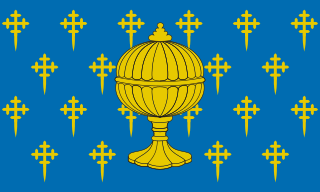
The Kingdom of Galicia was a political entity located in southwestern Europe, which at its territorial zenith occupied the entire northwest of the Iberian Peninsula. It was founded by the Suebic king Hermeric in 409, with its capital established in Braga. It was the first kingdom that officially adopted Catholicism. In 449, it minted its own currency. In 585, it became a part of the Visigothic Kingdom. In the 8th century, Galicia became a part of the newly founded Christian Kingdom of Asturias, which later became the Kingdom of León, while occasionally achieving independence under the authority of its own kings. Compostela became the capital of Galicia in the 11th century, while the independence of Portugal (1128) determined its southern boundary. The accession of Castilian King Ferdinand III to the Leonese kingdom in 1230 brought Galicia under the control of the Crown of Castile.
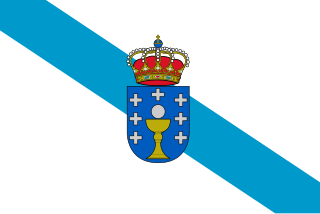
The flag of Galicia appeared for first time in the 19th century, probably based on the colours of the ancient medieval flags of the Kingdom of Galicia. Originally, the flag was probably a blue St Andrew's Cross over a white field – St Andrew is one of the most popular saints in Galicia. The coat of arms of Galicia was actually the former flag of the Kingdom of Galicia. The colors blue, white and gold were always related with Galicia. The chalice, with a silver host, and the golden crosses on blue background have been its symbol since medieval times. For some time it was thought that it was based on the flag of the maritime province of Corunna, but today it is known that the design is earlier.
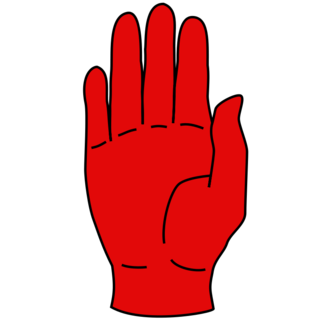
The Red Hand of Ulster is a symbol used in heraldry to denote the Irish province of Ulster and the Northern Uí Néill in particular. It has also been used however by other Irish clans across the island, including the ruling families of western Connacht and the chiefs of the Midlands.

The Coat of arms of Balearic Islands is described in the Spanish Law 7 of November 21, 1984, the Law of the coat of arms of the Autonomous Community of Balearic Islands. Previously, by Decree of the Interinsular General Council of August 7 and 16, 1978, adopted the coat of arms as official symbol of the Balearic Islands.
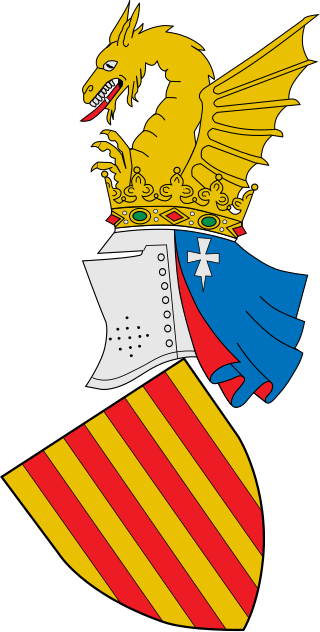
The coat of arms of the Valencian Community is the official emblem of the self-government institutions of the Valencian Community. It is based on the armorial achievement used from the reign of King Peter IV to John II, called the Great. In 1978 the former Council of the Valencian Country approved it “...for being the oldest known representative emblem of the former Kingdom of Valencia, that had located on the Xerea Gate of the city of Valencia”.

The so-called Bars of Aragon, Royal sign of Aragon, Royal arms of Aragon, Four Bars, Red Bars or Coat of arms of the Crown of Aragon, which bear four red pallets on gold background, depicts the familiar coat of the Kings of Aragon. It differs from the flag because this latter instead uses bars. It is one of the oldest coats of arms in Europe dating back to a seal of Raymond Berengar IV, Count of Barcelona and Prince of Aragon, from 1150.

A number of cross symbols were developed for the purpose of the emerging system of heraldry, which appeared in Western Europe in about 1200. This tradition is partly in the use of the Christian cross an emblem from the 11th century, and increasingly during the age of the Crusades. Many cross variants were developed in the classical tradition of heraldry during the late medieval and early modern periods. Heraldic crosses are inherited in modern iconographic traditions and are used in numerous national flags.
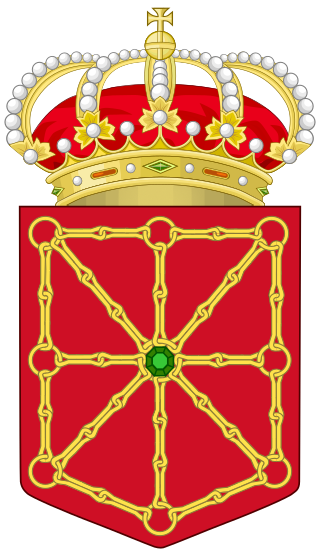
The coat of arms of Navarre is the heraldic emblem which for centuries has been used in Navarre. It was adopted as one of the official symbols of the Chartered Community of Navarre and is regulated by Foral Law 24/2003. It is commonly used by Navarrese municipalities in their own arms.
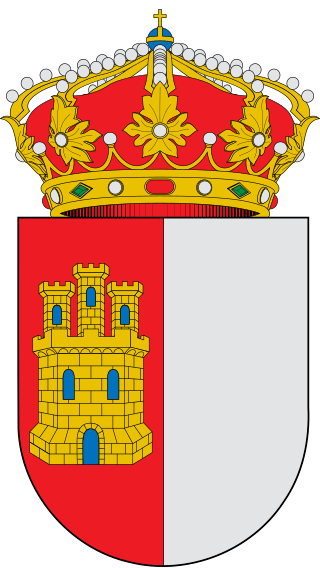
The coat of arms of the Castilla–La Mancha is described in the Spanish Law 1 of 30 June 1983, the Law of the coat of arms of Castilla-La Mancha Region and further regulated by Decree 132 of 5 July 1983, approving the official design of the coat of arms of Castilla-La Mancha and Decree 115 of 12 November 1985, supplementing Decree 132/1983.
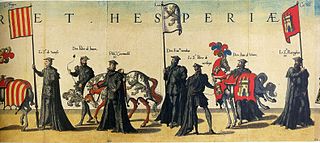
The first instance of a figure of the lion as symbol of the Kingdom of León is found in minted coins of Alfonso VII, called the Emperor (1126-1157). Until then, the cross had a preponderant position on documents and coins of Leonese monarchs since that reign the cross was gradually displaced by the lion. The Spanish historian and heraldist Martín de Riquer explained that the lion was already used as heraldic emblem in 1148. At the end of the reign of Alfonso VII, the figure of this animal began to appear on royal documents as personal device of the monarch and became pervasive during reigns of Ferdinand II (1157-1188) and Alfonso IX (1188-1230).

The coat of arms of Castile was the heraldic emblem of its monarchs. Historian Michel Pastoureau says that the original purpose of heraldic emblems and seals was to facilitate the exercise of power and the identification of the ruler, due to what they offered for achieving these aims. These symbols were associated with the kingdom, and eventually also represented the intangible nature of the national sentiment or sense of belonging to a territory.

The Ruthenian lion, Ukrainian (Russiae) lion, or Halychian (Galician) lion is a golden lion on an azure background. The lion was featured on the historic coat of arms of the Kingdom of Rus, the Ruthenian Voivodeship and the Western Ukrainian People's Republic. During the revolutions in the Austrian Empire in 1848, it became one of the national symbols of Ukrainians and the Ukrainian national liberation movement. Today it is featured on the coat of arms of the city of Lviv and its surrounding province, Lviv Oblast.

The coat of arms of Santiago de Compostela represents Santiago de Compostela, in the province of A Coruña, Galicia, Spain. The coat of arms combines Galician heraldry with traditions related to the city of Santiago de Compostela.


























